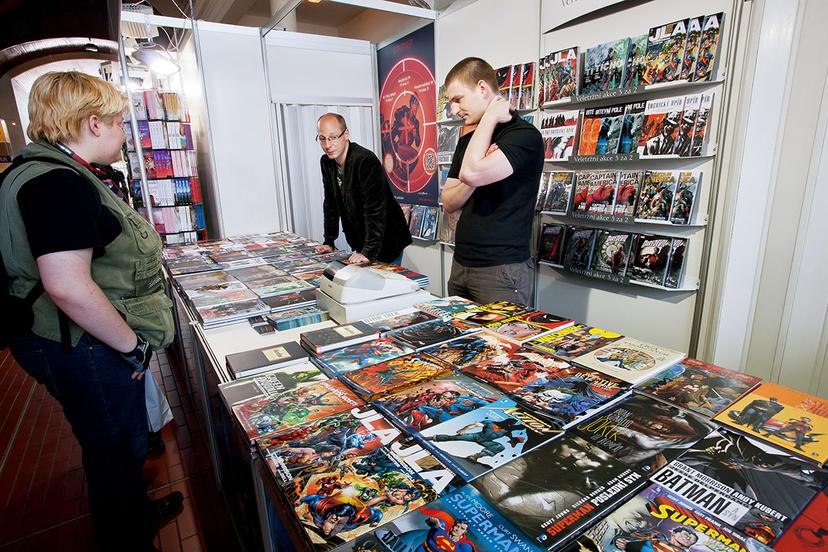Comic Books and Graphic Novels

Structure
Production of comic books and graphic novels usually involves a team of people from different occupations.
Editors
Editors plan and review the material that will be published. Acquisitions editors act as buyers for publishers, identifying writers and artists whose work will be valuable to publish. They may also suggest licensing existing characters from the movies or other media so that their stories can be told in comic-book form.
Developmental editors are involved in the creative process and in the production of the publication. They set up the production schedule and make sure that all the components meet their deadlines, from the writing and illustrating through the printing and publicity. They may review a draft of the story line and suggest changes to the plot or dialog. They review the artist's pencil sketches and may suggest a different visual effect or the placement of the word bubbles. They proofread the lettering and check for consistency of colors.
Editors usually come from an educational background that involves writing, such as a bachelor's degree program in literature, journalism, or communications. Experience in some other branch of the publishing industry is especially helpful.
Writers
Although some artists write their own material, many comic books and graphic novels are collaborative efforts. After developing a plot, the writer usually prepares a detailed outline for the artist, explaining what happens in each panel: the setting, perhaps the mood that is established, the action, and the dialog.
The medium allows great imaginative freedom for writers, but it also has severe limitations. Each panel must advance the action, and dialog is limited because word balloons intrude on the space available for art. A typical comic book has about five panels per page and 22 pages per issue. A story arc may be limited to one issue or may span four or five issues with the goal of future publication in paperback form.
Writers in this medium come from many backgrounds. Some have formal education in literary studies or creative writing. Some work exclusively on comic books or graphic novels, whereas others also write for other media.
The largest comic-book companies have staff writers, but most writers in this medium work as freelancers and are paid at per-page rate or by the issue or book. Outstanding writers of graphic novels may be able to negotiate royalty payments. A freelancer often will contact an editor and pitch a story idea in the form of a written proposal that outlines the plot and characters.
Artists
Many artists in this medium have formal training at an art school, where they learn anatomy and figure drawing, among other skills. Like the writers, they may be on the staff of a large publisher but more often work as freelancers who are teamed with a writer by the development editor and are paid by the page or issue.
Although computer graphic tools are available, many artists still work on paper with pencils or ink. They usually begin by storyboarding different scenes with quick sketches that the writer and editor can review and react to. The writer's and editor's suggestions help shape the artist's subsequent detailed work on individual panels. Some artists specialize in inking pencil drawings made by the original artist, and the coloring and lettering are often done by specialized artists.
Most comic-book artists do not write their own material, so they must give up a lot of creative control to the writer. If they work with an established character, they may also lose control over some aspects of how the character is illustrated. The medium itself makes certain unique demands. In the limited number of panels, the artist must create a mood and convey action.
Other Occupations
This industry also supports many business and administrative jobs in the publishing and distribution sectors. The migration of the medium to digital form is providing jobs for software developers. Comic book publishers have also established specific production departments to manage the conversion of print comic books to digital formats.
Major Employers
In the direct market (nonreturnable sales to comic-book shops), sales of comic books and graphic novels are dominated by two publishing groups, Marvel Comics and DC Entertainment, each of which accounted for roughly 40 percent of total unit sales in 2018. Image Comics, which publishes the highly successful series, The Walking Dead, is in distant third place, with about 10 percent of that market. Other leaders include IDW Publishing, Dark Horse Comics, Boom! Studios, and Dynamite Entertainment.
Distribution to the direct market is heavily dominated by Diamond Comic Distributors, although some book distributors reach this market. Publishers also distribute through newsstands. The migration of the medium to computerized platforms is opening new distribution channels: Web sites where digital comic books are purchased for download. Comixology is the dominant site in this market.
The industry's major trade show is the annual meeting of Comic-Con International in San Diego. Other major industry gatherings are the annual New York Comic Con, the Chicago Comic & Entertainment Expo, also known as C2E2, and Emerald City Comicon.